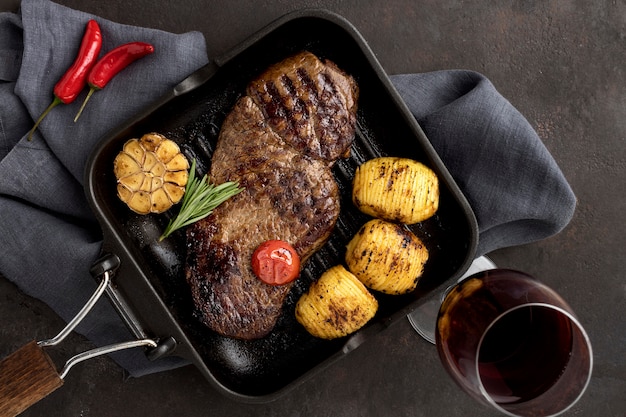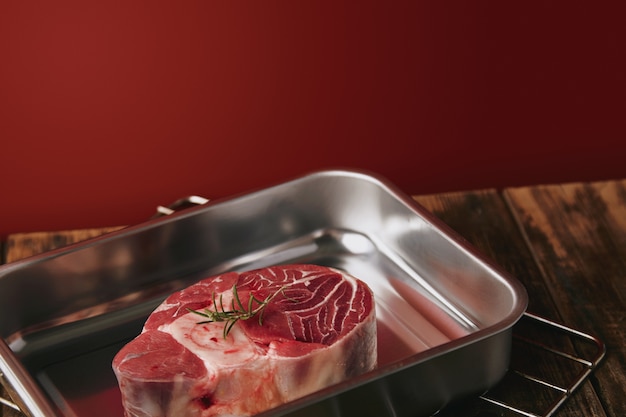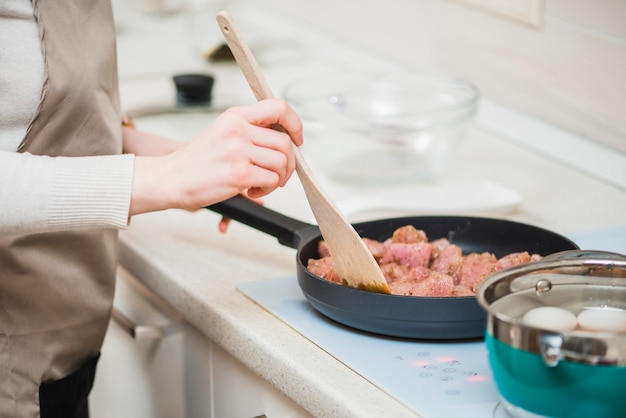There's something truly magical about a perfectly cooked brisket. That melt-in-your-mouth texture, the smoky aroma, the way it just falls apart on your fork – it's a culinary masterpiece. But let's be honest, the thought of tackling a brisket can be a bit intimidating. It's a big piece of meat, and it's got a reputation for being tricky. But I'm here to tell you, it's not as hard as you think, especially when you've got a trusty slow cooker by your side.
Over the years, I've tried countless brisket recipes, from classic oven-baked to fancy sous vide methods. But I've found that slow cooking is truly the way to go. It's a hands-off method that delivers consistently tender, juicy brisket every single time. You simply throw everything in the slow cooker, set it and forget it, and come back to a culinary masterpiece. It's like magic! And who doesn't love a bit of culinary magic, right?
So, are you ready to unlock the secrets of slow cooker brisket perfection? Let's dive in!
(Part 1) Choosing the Right Brisket

The first step to a fantastic brisket is picking the right cut. Now, don't be intimidated by the butcher shop! There are really only two main types of brisket you'll want to choose from:
The Point:
This is the fattier, more flavorful part of the brisket. It's the classic choice for a show-stopping main course because it'll melt in your mouth. Think of it as the "steak" of the brisket world. It's perfect for a big family gathering or a weekend barbecue. But be warned – it might be a little too rich for some. I find it's best served with a simple side of mashed potatoes and green beans, allowing the flavors to shine without overpowering.
The Flat:
The flat is leaner and more uniform in shape, making it ideal for slicing and serving. It's a bit less flavorful than the point, but it's still incredibly delicious. I like to think of it as the "roast" of the brisket world. It's perfect for a more casual gathering or a smaller meal. I like to pair it with a hearty salad and a side of roasted vegetables for a more balanced and lighter option.
When choosing your brisket, look for a piece that's well-marbled, meaning it has streaks of fat throughout. This fat will render down during cooking, keeping your brisket moist and juicy. You want to avoid a brisket that's too lean, as it might dry out and become tough. Remember, a little fat is your friend when it comes to brisket!
(Part 2) Preparing the Brisket for Slow Cooking

Once you've got your beautiful brisket, it's time to get it ready for the slow cooker. Here's my foolproof method:
Step 1: Trimming the Fat
The brisket you buy will likely have a thick layer of fat on top. You want to trim this down to about a quarter inch thick, leaving enough fat to keep the meat moist and flavorful. Don't worry about being too precise with your trimming; it's more about removing the excess fat. Think of it as giving your brisket a little "haircut." A sharp knife and a sturdy cutting board are all you need. And don't be afraid to ask your butcher for help if you need it!
Step 2: Scoring the Fat
Now comes the fun part – scoring the fat! This step is crucial because it allows the fat to render down evenly and creates beautiful grill marks. Use a sharp knife to make a series of diagonal cuts about half an inch deep, spaced about an inch apart. This will create a nice diamond pattern on the surface of the brisket. Scoring also gives the rub more surface area to adhere to. Imagine it as giving your brisket a little "massage" to ensure it cooks evenly and absorbs all the delicious flavors.
Step 3: Seasoning the Brisket
This is where you get to unleash your creativity. You can use a simple salt and pepper seasoning, or go all out with a homemade dry rub. I love using a blend of smoked paprika, garlic powder, onion powder, chili powder, brown sugar, and a touch of cayenne pepper for a kick. I like to generously rub the seasoning all over the brisket, making sure to get it into those scored lines. The secret here is to really get the seasoning into the meat, so it can develop those beautiful, smoky flavors during cooking.
(Part 3) The Slow Cooker Magic

Now, the moment we've all been waiting for – slow cooking the brisket. This is the part where you really get to relax and let the slow cooker do its thing. But before you just chuck the brisket in, there are a couple of crucial steps:
Step 1: The Base
I start by creating a delicious base for the brisket to cook in. I like to use a combination of beef broth and water for extra flavor and moisture. You can also add a splash of beer, apple cider, or even some red wine for a more complex flavor profile. I find that a little sweetness helps balance the savory notes of the brisket, so I add a tablespoon or two of brown sugar to the liquid. It's like creating a little "flavor bath" for your brisket.
Step 2: Slow and Low
The golden rule for slow-cooking brisket is to cook it on low heat for a long time. Aim for 8-10 hours on low, or 6-8 hours on high. The key is to cook it until it's incredibly tender and the fat has rendered down. I always set a timer to remind me to check the brisket a couple of times during cooking, just to make sure it's not drying out. This is where patience is key – let the slow cooker work its magic!
Step 3: Rest and Slice
After cooking, let the brisket rest for at least an hour in the slow cooker before slicing. This allows the juices to redistribute, resulting in a juicier, more flavorful brisket. To slice the brisket, use a sharp knife to cut across the grain. This will make the meat easier to chew and give it a more tender texture. It's like letting the brisket "breathe" before you carve it up.
(Part 4) Serving Up Your brisket masterpiece
Now for the most satisfying part – serving your perfectly slow-cooked brisket. Here are a few ideas to make your meal truly unforgettable:
1. The Classic Brisket Sandwich:
Forget those dry, boring deli sandwiches! This is the real deal. Slice the brisket thinly, pile it high on a crusty roll, and top it with your favorite bbq sauce. I'm a big fan of a tangy, smoky sauce, but you can use whatever your heart desires. Think of it as a delicious ode to the classic barbecue sandwich.
2. Brisket Tacos:
If you're feeling adventurous, try turning your brisket into delicious tacos. Shred the meat and toss it with your favorite taco seasoning. Serve it on warm tortillas with all your favorite toppings, like shredded cheese, sour cream, salsa, and avocado. It's a fiesta in your mouth! This is a fun and creative way to use leftover brisket, and it's always a crowd-pleaser.
3. Brisket Hash:
Use up your leftover brisket by making a hearty hash. Chop the meat into small pieces and sauté it with potatoes, onions, and peppers. Season it with salt, pepper, and your favorite spices. It's a delicious and satisfying way to use up those last bits of brisket. This is a great way to make a quick and easy meal with your leftover brisket.
(Part 5) The Art of BBQ Sauce
No slow cooker brisket experience is complete without a good BBQ sauce. While you can certainly purchase your favorite store-bought sauce, I find that nothing beats the taste of a homemade sauce. Here's my recipe for a classic smoky BBQ sauce:
Ingredients:
- 1 cup ketchup
- 1/2 cup apple cider vinegar
- 1/4 cup brown sugar
- 2 tablespoons Worcestershire sauce
- 1 tablespoon smoked paprika
- 1 teaspoon garlic powder
- 1 teaspoon onion powder
- 1/2 teaspoon black pepper
- 1/4 teaspoon cayenne pepper (optional)
Instructions:
- Combine all ingredients in a saucepan.
- Bring to a simmer over medium heat, stirring constantly.
- Reduce heat to low and simmer for 15 minutes, or until the sauce has thickened slightly.
- Remove from heat and let cool slightly before serving.
This sauce is a perfect balance of sweet, tangy, and smoky flavors. You can adjust the spice level to your liking by adding more or less cayenne pepper.
(Part 6) Variations and Experimentation
Now that you've got the basic slow cooker brisket recipe down, it's time to get creative! There are endless possibilities when it comes to flavoring and serving this dish. Here are a few ideas to get you started:
1. Spicy Brisket:
Amp up the heat by adding a generous amount of cayenne pepper to your dry rub. You can also use a fiery BBQ sauce or top your brisket with some jalapeno slices. For those who like a little extra kick!
2. Honey Garlic Brisket:
For a sweet and savory twist, mix honey and garlic into your BBQ sauce or add them to your dry rub. This combination adds a delicious glaze to the brisket. This is a great option for those who prefer a more sweet and savory flavor profile.
3. Chipotle Brisket:
Embrace smoky, smoky flavors by incorporating chipotle peppers into your dry rub or BBQ sauce. The smoky heat of the chipotles complements the richness of the brisket beautifully. This is a great option for those who love smoky flavors and want to add a touch of depth to their brisket.
4. Asian-Inspired Brisket:
For a unique twist, use Asian-inspired flavors like soy sauce, ginger, and garlic. You can also add a splash of sesame oil to the slow cooker or use a teriyaki-based sauce. This is a great way to add a touch of global flair to your brisket.
(Part 7) Tips and Tricks for Slow Cooker Brisket Success
I've learned a thing or two about slow-cooking brisket over the years, and I'm happy to share my secrets with you! Here are a few tips to help ensure your brisket turns out perfectly:
1. Don't Overcrowd the Slow Cooker:
Give your brisket plenty of room to cook evenly. If your slow cooker is too small, you may need to cook the brisket in two batches. A crowded slow cooker can prevent the brisket from cooking evenly, leading to dry spots or undercooked areas.
2. Monitor the Liquid Levels:
As the brisket cooks, the liquid will evaporate. Make sure to check the level every couple of hours and add more broth or water if necessary. This will help keep the brisket moist and prevent it from drying out.
3. Use a meat thermometer:
The best way to ensure your brisket is cooked through is to use a meat thermometer. The internal temperature should reach 190-205 degrees Fahrenheit for the most tender and flavorful brisket. A meat thermometer is your best friend when it comes to brisket! It's the only way to guarantee that it's cooked to perfection.
4. Don't Be Afraid to Experiment:
The beauty of slow cooking is that it allows you to experiment with different flavors and techniques. Don't be afraid to try new things and find what works best for you. Have fun with it and see what kind of brisket magic you can create!
(Part 8) Beyond the Brisket: Delicious side dishes
No slow cooker brisket feast is complete without a delicious spread of side dishes. Here are some of my favorites:
1. creamy mashed potatoes:
The classic pairing for brisket! You can't go wrong with a big bowl of creamy mashed potatoes. This is a timeless combination that brings comfort and warmth to any meal.
2. Macaroni and Cheese:
For a cheesy and comforting side, whip up a batch of macaroni and cheese. You can use a boxed mix or make it from scratch. This is a crowd-pleaser that pairs perfectly with the richness of the brisket.
3. Green Beans with Almonds:
This simple side dish is packed with flavor and texture. Steam some green beans and toss them with toasted almonds and a sprinkle of salt and pepper. This adds a touch of freshness and crunch to the meal.
4. Cornbread:
No Southern feast is complete without cornbread! You can bake it from scratch or use a mix. Serve it warm with a pat of butter. This is a classic Southern staple that pairs perfectly with the savory flavors of brisket.
5. Coleslaw:
For a refreshing and tangy side, whip up a batch of coleslaw. You can use a store-bought mix or make it from scratch. This adds a touch of brightness and tang to the meal.
(Part 9) Storage and Leftovers
You've made the perfect brisket, and now it's time to enjoy the leftovers! Here's how to store and reheat your brisket:
Storage:
Let the brisket cool completely before storing it in an airtight container in the refrigerator for up to 4 days. This will help to prevent bacteria growth and keep your brisket fresh.
Reheating:
You can reheat the brisket in the oven, microwave, or slow cooker. If you're using the slow cooker, just add a little broth or water to the bottom of the slow cooker and set it on low heat for a few hours. For the oven, preheat your oven to 300 degrees Fahrenheit and heat the brisket until it's warmed through. For the microwave, microwave the brisket in 30-second intervals until heated through.
Now, here's the really great part about brisket – it tastes even better the next day! The flavors have time to meld and the meat becomes even more tender. You can even use leftover brisket to make delicious sandwiches, tacos, or salads. It's like a culinary gift that keeps on giving!
FAQs
1. How do I know if my brisket is done?
The best way to tell if your brisket is done is to use a meat thermometer. The internal temperature should reach 190-205 degrees Fahrenheit. The meat should also be incredibly tender, pulling apart easily with a fork. If you poke the brisket with a fork, the juices should run clear, not pink. This is a sign that the brisket is cooked through and ready to enjoy.
2. What if my brisket is dry?
If your brisket turns out a little dry, you can try adding a little more liquid to the slow cooker or wrapping the brisket in foil before cooking. You can also make a delicious sauce to serve over the brisket to add moisture and flavor. There are a few tricks you can try to save a dry brisket. Don't fret – you can still salvage it!
3. Can I freeze brisket?
Yes, you can freeze brisket for up to 3 months. Wrap the brisket tightly in plastic wrap and then place it in a freezer-safe bag. To thaw the brisket, transfer it from the freezer to the refrigerator overnight. This is a great way to save time and make sure you always have delicious brisket on hand.
4. What are the best slow cooker settings for brisket?
The best slow cooker setting for brisket is low heat for 8-10 hours, or high heat for 6-8 hours. The key is to cook it slowly and low to ensure that the meat is tender and juicy. Slow and low is the key to a perfect brisket!
5. Can I use a different cut of meat for this recipe?
While brisket is the traditional choice for this recipe, you can use other cuts of beef, such as chuck roast or shoulder. Just be sure to adjust the cooking time accordingly. These cuts will likely require less cooking time than brisket. Feel free to experiment and find what works best for you.
And there you have it! My ultimate guide to slow cooker brisket. Now go forth and conquer the world of tender, juicy beef. I promise, you won't be disappointed!
Everyone is watching

Prime Rib Roast Cooking Time Chart: Per Pound Guide
Cooking TipsPrime rib roast. Just the name conjures images of lavish dinners, crackling fires, and hearty laughter. It’s ...

How Long to Bake Potatoes in the Oven (Perfect Every Time)
Cooking TipsBaked potatoes are a staple in my kitchen. They're incredibly versatile, delicious, and surprisingly easy to m...

Perfect Rice Every Time: The Ultimate Guide to Cooking Rice
Cooking TipsAs a self-proclaimed foodie, I've always been a bit obsessed with rice. It's the foundation of countless cuisi...

The Ultimate Guide to Cooking Asparagus: Tips, Techniques, and Recipes
Cooking TipsAsparagus. The mere mention of this spring delicacy conjures up images of vibrant green spears, crisp and burs...

Ultimate Guide to Cooking the Perfect Thanksgiving Turkey
Cooking TipsThanksgiving. Just the word conjures up images of overflowing tables laden with delicious food, the scent of r...
